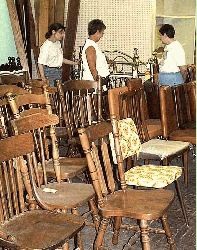The home furnishings time forgot
Published 12:00 am Tuesday, August 12, 2003

- Customer Carmen Ott, center, looks over a brass headboard with Rosalyn Neuberger, left, and Pat Neuberger. The Neubergers are sisters, and nieces of the late Hans and Bert Neuberger, whose former Baker Furniture store still contains dozens of brand-new pieces dating as far back as the 1940s. (Baker City Herald photo).
By JAYSON JACOBY
Trending
Of the Baker City Herald
Did you ever want to be the Beaver?
Wish you were one of My Three Sons?
Trending
Rosalyn and Pat Neuberger can’t supply Eddie Haskell.
But they’ll sell you the perfect lamp.
And a spiffy dinette set with Naugahyde chairs and a blatantly fake wood-grain table top that Ozzie would have adored.
Harriet, too.
Step inside Baker Furniture and you can’t help but expect Alice to appear with a plate of cookies, so fresh the chocolate chips still ooze.
Parallel lines of lamps extend from near wall to far in the long but narrow room.
Lamps with round bases and square bases and bases with shapes rarely seen except in obscure geometry texts and Montgomery Ward catalogues circa the Johnson administration.
There are lamps finished in bright brass and lamps painted in dull browns and a few bearing that odd shade of avocado they used to slather on everything from toasters to tea cups but that disappeared from stores about the time Carter was inaugurated.
But not from this store.
Here, with their pastels and earth-tones proudly displayed, the 1950s and 1960s persist.
Their furniture does, anyway.
Rosalyn and Pat are sisters, the nieces of the late Hans and Bert Neuberger. The brothers owned Baker Furniture and sold household goods in Baker City for more than 40 years.
As did their elder surviving brother, 88-year-old Gert, who is Rosalyn and Pat’s father.
Hans died in 1997, Bert four years later.
They were lifelong bachelors.
After Bert died, Rosalyn and Pat, both of whom grew up in Baker City but now live in Portland, returned to their hometown to settle their uncles’ estate.
Baker Furniture, at 1916 Main St., constitutes a big part of that estate.
And more than two years later, it’s the part not yet settled.
When the sisters arrived at the store in 2001 they expected to find a hodge-podge of inventory in the showroom.
They did not expect to find the basement crammed with boxes of lampshades nestled between crumpled issues of the New York Times from 1955.
andquot;As we started unpacking we’d find stuff from the ’40s, the ’50s, the ’60s,andquot; Rosalyn said.
Every piece brand-new, too, although that term seems inappropriate for items manufactured prior to the Kennedy assassination.
Rosalyn surmises that her uncles, when they moved to the Main Street building in 1960, packed all their inventory but then failed to reverse the process once they were ensconced in their new store.
andquot;They just never unpacked because more modern stuff was coming in,andquot; she said.
As the sisters sorted through the lamps and the chairs and the bookcases, their strategy for a quick and tidy weekend liquidation sale began to seem a bit presumptuous.
What, they wondered, were they to do with all this stuff?
(Besides wipe away a few pounds of dust, of course.)
Yet to the sisters’ surprise, the nostalgia for andquot;Father Knows Bestandquot;-era furniture has thickened considerably over the decades.
During Miners Jubilee in July 2001, on a whim, they opened the store.
andquot;We thought, ‘Why not, it’s sidewalk sale time,’ andquot; Rosalyn said.
Dozens of people stopped by.
Many were longtime Baker City residents who had bought furniture from the Neubergers, and wanted to pay their respects to the brothers, Rosalyn said.
andquot;They enjoyed their store, and they enjoyed people,andquot; she said. andquot;I was amazed at how highly regarded Bert and Hans were.andquot;
But then the sisters noticed that most passers-by, after saying their words of condolence, seemed distracted by an ornate headboard, or captivated by the sleek chrome lines of a diner-style chair.
Inevitably, this unexpected reverence for what Rosalyn calls andquot;retroandquot; design, combined with marked-down merchandise, convinced many of the well-wishers to unlimber their wallets and walk out with, say, a lamp that resembles the bottle in which Barbara Eden lived in andquot;I Dream of Jeannie.andquot;
andquot;Plus,andquot; Rosalyn said, andquot;people just love to shop.andquot;
Pretty soon the stock of gaudily upholstered easy chairs and McCarthy-vintage coffee tables began to dwindle to more reasonable proportions.
Since then the sisters have opened the store for a week every month except when snow slickens the freeway between Portland and Baker City.
andquot;We never intended to sell,andquot; Rosalyn said. andquot;We were just cleaning up, sorting through old business records.
andquot;This has been our own little unintended adventure.andquot;
Emptying out, in a way
Although the store still appears well-stocked the room next to the lamp-filled corridor contains a conglomeration of chairs and tables and the occasional mirror the Neuberger sisters said the place seems to them rather empty.
At least all the mattresses have been lugged away.
andquot;At first it was pretty well packed,andquot; Rosalyn said.
Yet what’s left makes for quite an eclectic selection just the sort of legacy you might expect from a pair of brothers who were in business for more than four decades but deigned to let a single item leave the premises without a sales receipt attached.
Leaning against the north wall is a Proctor Citation folding ironing board that boasts, according to the sticker affixed to its pale yellow ironing surface, andquot;all new modern features.andquot;
Modern as Mamie Eisenhower defined the term, maybe.
Stacked on a nearby table are assorted mismatched orphans tiny plastic wheel casters and 100-watt bulbs and thermometers used to test the accuracy of oven gauges.
There’s a stack of Cornell plates, and the woman on the package, shown offering a plateful of some decadent delicacy to an obviously enthralled young girl, is the spitting image of Carol Brady.
But that’s just bric-a-brac.
The store’s more popular items, Rosalyn said, are the lamps and the tables and the chests of drawers.
Customers seem stunned, she said, when they learn that they can buy never-used relics from a time when you had to actually touch a television to turn it on, and the pictures it showed came in only two colors: black and white.
andquot;A lot of this stuff is old enough now that people would be going to second-hand shops to find it,andquot; Rosalyn said. andquot;But they come in here and they find out it’s still new.andquot;
She has sold pieces to people who want to decorate their homes in a ’50s motif andquot;shabby chicandquot; it’s sometimes called.
And students preparing to furnish their first college apartment or dorm seem especially entranced by the garish fabrics and chocolate tear-drop lamps.
andquot;It was really trendy when it was new, then it went through a period when no one wanted it, and now it’s coming back into style,andquot; Rosalyn said. andquot;It’s like a life cycle.
andquot;The ’50s are collectible.andquot;
Last week a man from Central Oregon, a collector who deals vintage furniture on the Internet, bought several hanging lamps.
Pat said the man’s eyes widened when he walked inside the store.
andquot;He was shocked,andquot; she said. andquot;And he knew what he was seeing he knew the stuff was new.andquot;
The Neubergers don’t intend to peddle their wares online, although they admit the collection could send ’50s afficionados scurrying to their keyboards.
Nor do they know how many more one-week sales they will schedule.
The next is set for Sept. 8-13.
andquot;As long as we need to,andquot; Rosalyn said. andquot;It’s more like a hobby now.
andquot;Besides, we’re always going to come back and visit mom and dad.andquot;









